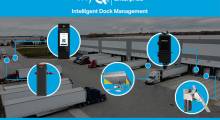While the benefits of reusable, returnable pallets have long been enjoyed in certain industries—consumer packaged goods (CPG), food and beverage, and automotive among them—for other industries, the switch from wood to another material (like plastic) hasn’t been feasible.
That’s because the strength-to-weight ratio of plastic pallets generally isn’t high enough to accommodate ultra-heavy loads, while still being lightweight enough for manual handling and durable enough to withstand multiple return trips.
“We chose a composite material that is stronger than steel to form the BLOCKPal pallet,” explains David Kalan, senior director of business development for RM2 USA. “It even feels like steel, but it’s made of fiberglass and resin.”
When compared to the 2,800-pound, edge-racking specification for a 48 x 40-inch GMA pallet, “the BLOCKPal’s racking load measures at 6,500 pounds, static loads at 60,000 pounds, and dynamic loads at 9,800 pounds,” Kalan adds.
That means the BLOCKPal gives industries handling heavy, dense materials—such as stone, masonry, metal, tooling and others—the chance to reduce their logistics costs, including cost per trip, damaged pallet waste, or product losses caused by weakened shipping platforms.
Additionally, thanks to the inherent strength of the material, BLOCKPal pallets can be formed in a lower height profile with larger lift truck openings than 9-block wood or plastic pallets. “That means we can get 640 of our empty pallets in a load versus 540 plastic or wood pallets,” Kalan adds. “That’s a 17% freight savings.”
Non-porous and rackable, the material can be affordably pultruded into myriad standard pallet dimensions, as well as specific sizes unique to other industries, he says. Further, the material is naturally fire-resistant without additives, and withstands temperatures from -40°F to 176°F. Like plastic, the material can be recycled through a re-grind process at the end of a pallet’s usable life.
Unlike plastic, however, the BLOCKPal’s material has no aftermarket value. “It essentially returns to silica sand,
reducing the chance of mass theft,” says Kalan.
To help users keep closer tabs on each pallet’s whereabouts and fully maximize the benefits of a pallet pooling system, the company includes tracking with its ERICA asset management system, which also monitors other returnable assets and equipment, regardless of the supplier.








